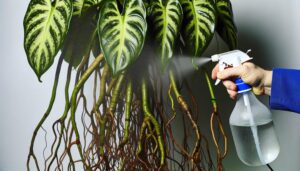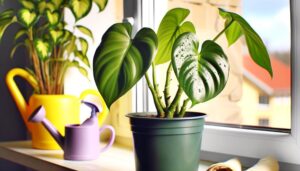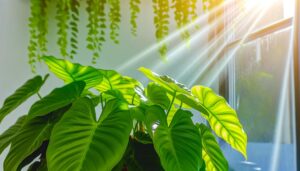Black Cherry Philodendron Care: A Complete Guide
Black Cherry Philodendron, or Philodendron melanochrysum, thrives in conditions that mimic its tropical home. Make sure it’s placed in a location with bright yet filtered light, avoiding direct sunlight.
Water it weekly with distilled or rainwater, maintaining consistently moist soil with proper drainage. Temperatures should range from 65-80°F with a humidity of 40-60%.
Fertilize regularly with diluted, balanced, water-soluble fertilizer. Consider repotting when it becomes root-bound and conduct frequent checks for pests.
By understanding more about its unique features, you’ll be well-prepared for any growing conditions or problems that might arise, enhancing your plant’s health and longevity.
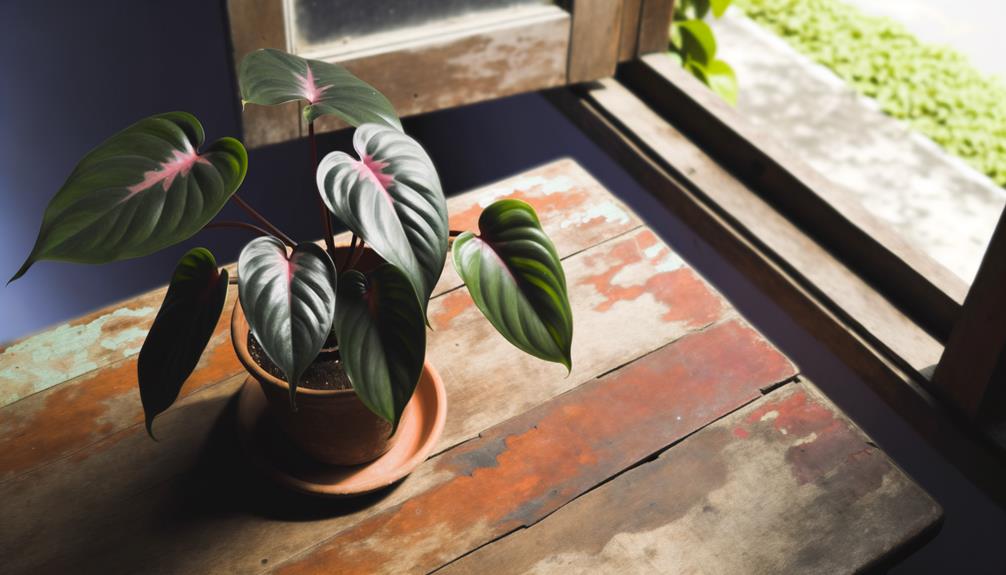
Key Takeaways
- Black Cherry Philodendron thrives in bright, filtered light, avoiding direct sunlight.
- It prefers watering once a week with rainwater or distilled water to keep soil moist but not waterlogged.
- The plant thrives in temperatures of 65-80°F and 40-60% humidity with minimal seasonal variation.
- Fertilize regularly with a balanced, water-soluble fertilizer every 4-6 weeks during the growing season.
- Check regularly for pests, maintain cleanliness and good air circulation, and use eco-friendly pesticides for pest control.
Understanding Black Cherry Philodendron
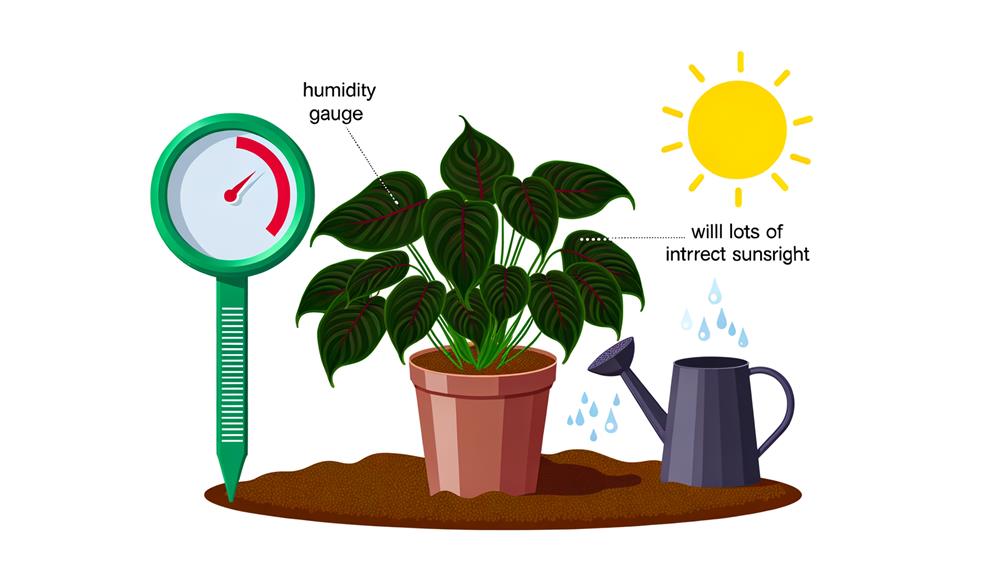
The Black Cherry Philodendron, scientifically known as Philodendron melanochrysum, is a mesmerizing tropical plant native to South America, distinguished by its lush, heart-shaped leaves and dramatic dark coloration.
This plant belongs to the Araceae family, known for their striking foliage and unique adaptation capabilities. It is an epiphytic variety, meaning it can thrive on the surface of other plants and draw nutrients from the air, rain, water, or from debris accumulating around it. Hence, it portrays a perfect symbiotic relationship, offering shelter and nutrients to its host plant without causing any harm.
Being a tropical species, it prefers a humid environment and well-draining soil. Understanding these unique features will help in providing the best care, nurturing this enchanting marvel of nature to its full potential.
Ideal Light Conditions
The Black Cherry Philodendron flourishes under specific light conditions, which are essential for its best growth and development. A thorough understanding of its light requirements is necessary for ensuring its health and longevity.
Additionally, a comparison between indoor versus outdoor lighting can provide insights into the most suitable environment for this plant species.
Understanding Light Requirements
Proper illumination plays an important role in the overall health of a Black Cherry Philodendron, with diffused or indirect sunlight being ideal. This species is highly adaptable and can thrive in a variety of light conditions, however, it is most successful in bright but filtered light.
Direct sunlight is to be avoided as it can cause leaf burn, a detrimental condition that can severely impact plant health. Conversely, too little light can lead to stunted growth and lackluster foliage.
For best growth, provide a light source akin to dappled forest light, mimicking the Black Cherry Philodendron’s natural habitat. Understanding these light requirements is optimal in ensuring the longevity and vibrancy of your Black Cherry Philodendron.
Indoor Vs Outdoor Lighting
Finding the difference between indoor and outdoor lighting conditions is a pivotal aspect in preserving the radiant health of a Black Cherry Philodendron.
- Indoor Lighting: This plant prefers low to medium light conditions when grown indoors. Direct exposure to sunlight can cause leaf burn.
- Outdoor Lighting: When grown outside, Black Cherry Philodendrons require a combination of shade and filtered light. Direct sunlight can again cause damage to the leaves.
- Ideal Light Conditions: Regardless of the location, the best light conditions for this plant are bright but indirect light.
Understanding these subtle but pivotal differences between indoor and outdoor lighting conditions is essential to ensure the optimal health, growth, and vibrancy of your Black Cherry Philodendron.
Proper Watering Techniques
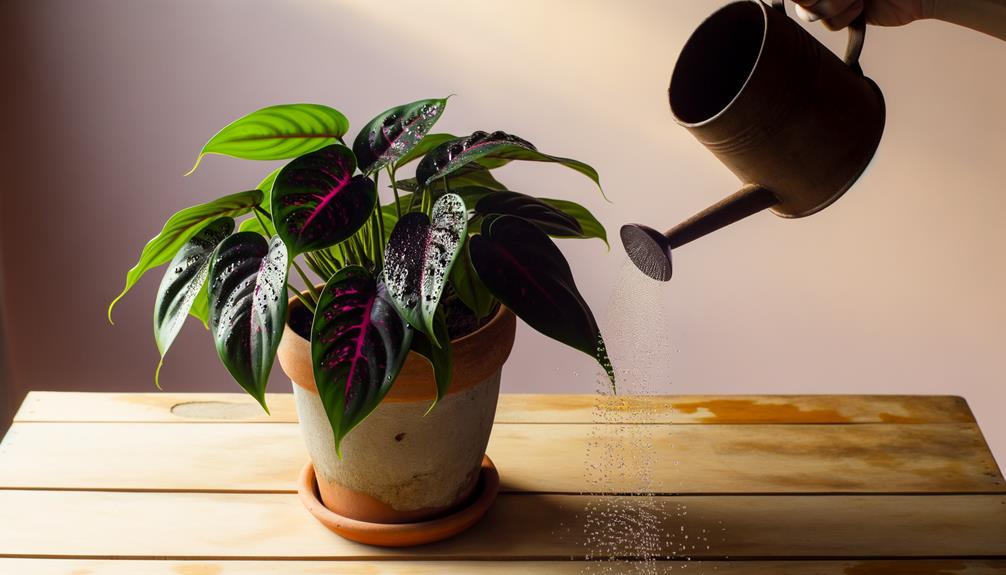
The correct hydration of a Black Cherry Philodendron is a critical factor in its overall health and vigor. Understanding the plant’s unique water needs and being attentive to signs of overwatering are key to preventing a range of harmful health issues.
Setting up a watering schedule that suits the plant’s requirements is vital for its flourishing and showcasing its distinctive vibrant foliage.
Understanding Water Requirements
Sufficient hydration, a pivotal element of Black Cherry Philodendron care, hinges on a deep understanding of the plant’s unique water requirements and the implementation of effective watering techniques.
To achieve optimal growth, consider the following key factors:
- Frequency of Watering:
Philodendrons typically require watering once a week. However, frequency can vary depending on environmental conditions.
- Water Quality:
Utilize rainwater or distilled water, if possible, as these plants can be sensitive to the salts and chemicals found in tap water.
- Soil Moisture Level:
Keep soil consistently moist, but not waterlogged. A moisture meter can provide accurate measurements.
Overwatering: Signs and Solutions
Recognizing the signs of overwatering and implementing appropriate solutions is essential to maintain the health and longevity of your Black Cherry Philodendron. Overwatering can lead to root rot and eventually, plant death. Early symptoms include yellowing leaves, wilting, and stunted growth.
A thorough understanding of these signs will enable you to serve your plant better. Here’s a table to assist you:
| Signs of Overwatering | Scientific Explanation | Solutions |
|---|---|---|
| Yellowing leaves | Excess water hinders oxygen uptake, causing chlorosis. | Reduce watering frequency. |
| Wilting | Waterlogged soil disrupts root functioning. | Improve soil drainage. |
| Stunted growth | Saturated soil limits nutrient absorption. | Ensure proper pot size and soil type. |
Understanding these signs and solutions will help you better care for your Black Cherry Philodendron, preventing the detrimental effects of overwatering.
Optimal Watering Schedule
Establishing a best watering schedule is vital for the Black Cherry Philodendron, as it greatly impacts the plant’s overall health, growth, and resilience.
To cultivate a thriving Philodendron, consider the following guidelines:
- Frequency: Water the plant approximately once a week during the growing season.
- Volume: Saturate the soil thoroughly, making sure water drains out the bottom of the pot.
- Timing: Water in the early morning or late evening to maximize absorption and minimize evaporation.
Keep in mind, these factors can vary based on environmental conditions; adjust as necessary.
A key sign of proper watering is a vibrant, lush plant. By adhering to these guidelines, you secure the well-being of your Philodendron, a tribute to your dedication to nurturing life.
Temperature and Humidity Preferences
The Black Cherry Philodendron thrives in a climate that mimics its tropical origins, with a temperature range of 65-80°F (18-27°C) and a relative humidity level of 40-60%. This plant is quite adaptable and can tolerate variations in these ranges. However, for ideal growth and to prevent leaf curling or yellowing, it’s best to maintain these conditions consistently.
Below is a detailed table that provides a quick reference guide for these preferences:
| Condition | Preferred Range | Tolerance Range |
|---|---|---|
| Temperature | 65-80°F (18-27°C) | 60-85°F (15-29¼) |
| Humidity | 40-60% | 30-70% |
| Day Light Hours | 10-12 hours | 8-14 hours |
| Night Length | 12-14 hours | 10-16 hours |
| Seasonal Variation | Minimal | Moderate |
Fertilizing Your Philodendron
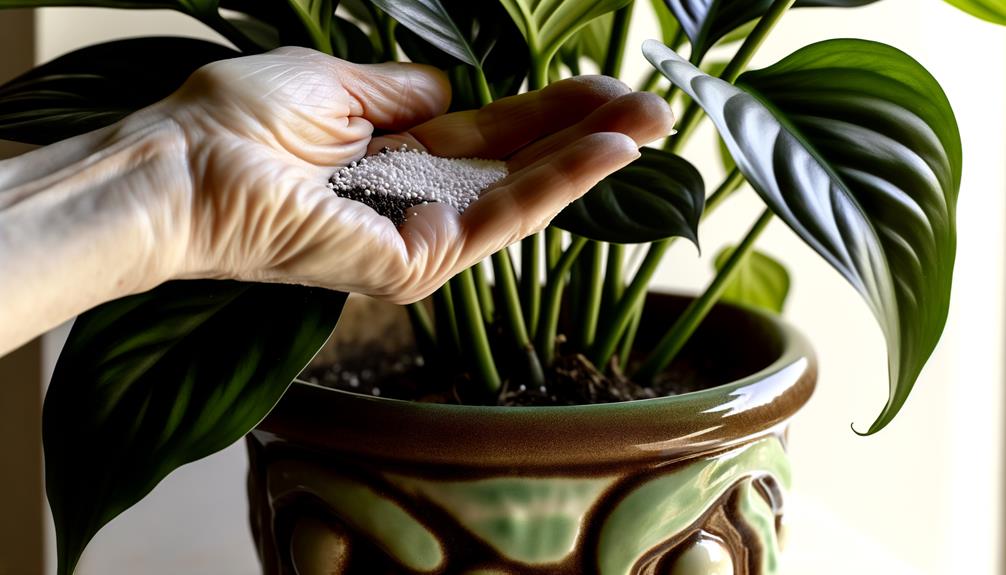
To guarantee the best health and vigor of your Black Cherry Philodendron, a regular fertilizing regimen is essential, preferably using a balanced, water-soluble fertilizer rich in micronutrients. The ideal frequency of application depends on the plant’s growth phase and environmental conditions. However, generally, it should be applied every four to six weeks during the growing season.
To further add sophistication to your fertilizing process, consider the following three steps:
- Always water your plant thoroughly before applying fertilizer to prevent root burn.
- Dilute the fertilizer to half its recommended strength to avoid over-fertilization.
- In winter, reduce fertilizing frequency or cease altogether as the plant’s growth slows.
Pruning and Repotting Tips
Maintaining the ideal size and shape of your Black Cherry Philodendron involves a regular regimen of careful pruning and timely repotting. Pruning should be done in late winter or early spring, cutting back to a leaf node to promote bushier growth. Use sterilized pruning shears to avoid transmitting diseases.
When the plant becomes root-bound, it is time for repotting. Choose a pot 1-2 inches larger in diameter than the current one, ensuring it has ample drainage holes. Use a peat-based potting mix for best growth. Carefully remove the plant, untangling any circling roots. Place in the new pot, filling with soil around the edges. Water thoroughly after repotting to settle the soil and eliminate air pockets.
Pest Control and Disease Prevention
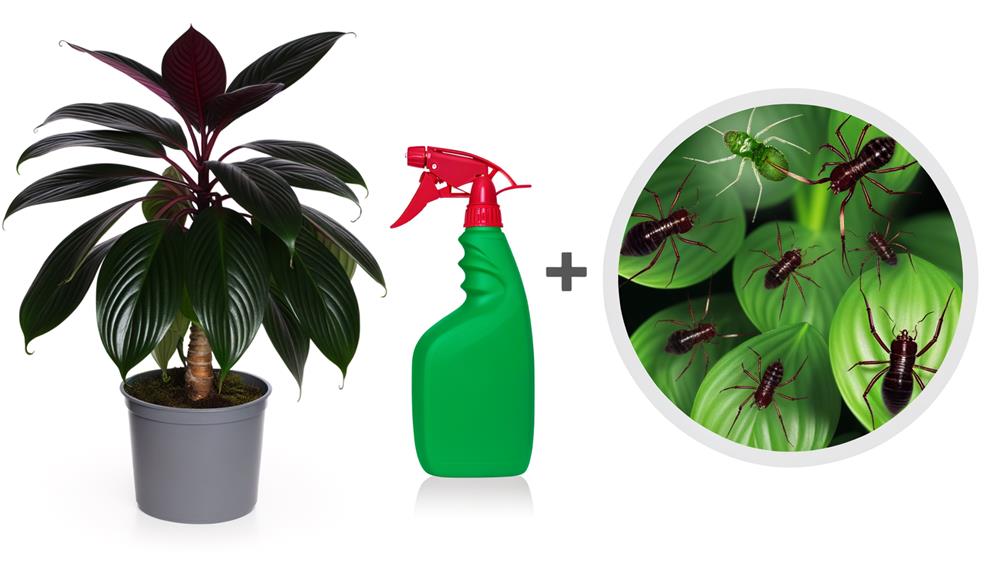
While careful pruning and repotting help maintain the health and aesthetics of your Black Cherry Philodendron, an equally important aspect of plant care involves effective pest control and disease prevention strategies.
Regular Inspection: Schedule periodic checks for signs of pests such as aphids, spider mites, and mealybugs. The earlier you catch an infestation, the easier it is to manage.
Preventive Measures: Maintain cleanliness around the plant area to discourage pests. Guarantee good air circulation and avoid overwatering, as damp conditions can foster fungal diseases.
Treatment: Use eco-friendly pesticides and fungicides, if necessary. For severe cases, consider professional pest control services.
Conclusion
To sum up, the black cherry philodendron can flourish and showcase its dazzling beauty under ideal circumstances – sufficient light, appropriate watering, optimal temperature, and humidity levels.
Consistent fertilizing, trimming, and repotting improve its general well-being. Being watchful for pests and diseases is crucial.
It resembles the Victorian-era gentleman gardener, precise in its maintenance yet gratifying you with its magnificent foliage, a proof of the excellence of your horticultural effort.

